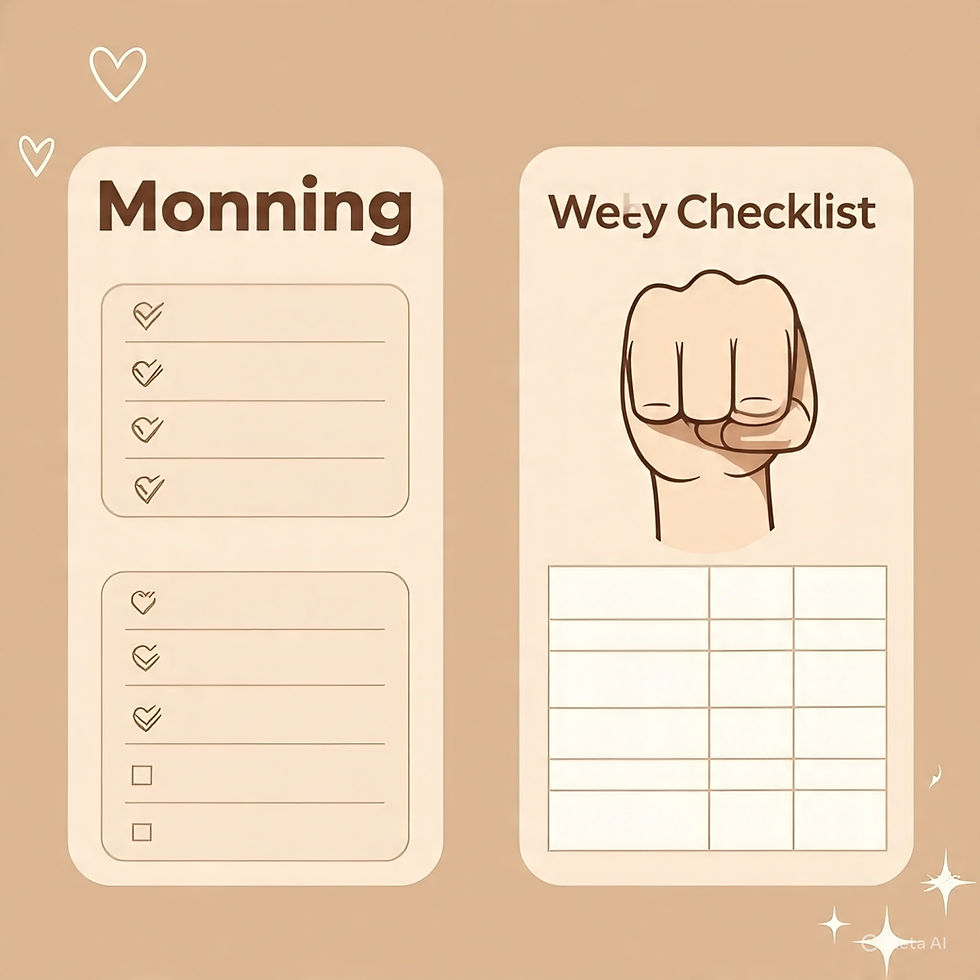How to Build a Self-Care Routine You'll Actually Stick To
- Quiet Alchemy
- Jun 22
- 4 min read
Updated: Jun 29
In a world that moves fast and demands more, self-care is no longer a luxury—it’s a survival tool. But let’s be honest: how many times have you started a self-care routine only to drop it after three days? We set ambitious goals, copy other people’s routines from social media, and then wonder why we can’t keep up.
The truth? Self-care isn’t about perfection or productivity. It’s about creating a system that nourishes your mind, body, and spirit in a sustainable 🌿 What Self-Care Really Means (It’s Not Just Face Masks)
Self-care is any action you take deliberately to support your physical, mental, or emotional well-being. It can be:
Saying "no" to an extra project
Drinking water when you’re tired instead of more coffee
Taking 10 minutes to stretch between study sessions
Journaling your thoughts so they don’t pile up in your head
It’s not just about bubble baths and sheet masks. Real self-care can be messy, quiet, or boring—but it should feel like a relief, not pressure.

🧩 Step 1: Identify What You Really Need Right Now
Before you actually start listing what to do, ask yourself: What do I actually need right now?
Here’s a simple breakdown to help:
🧠 If you feel anxious or stressed:
Try deep breathing, guided meditation, or going for a short walk
💪 If your body feels tired or low:
Prioritize sleep, hydration, gentle stretching, or a nourishing meal
❤️ If you feel emotionally off:
Journal, talk to someone you trust, or listen to calming music
Whenever I feel emotional or stressed I just talk to myself, try it out yourself if there's something you can't talk about with other and talk to yourself you'll feel light.
Self-care routines only work when they solve a real problem. Your needs may change weekly or daily, and your routine should adjust with you.

📋 Step 2: Start With One Non-Negotiable Habit
The biggest mistake people make? Trying to overhaul everything at once.
Start with just one daily habit that feels doable—even when you're tired.
Some great first habits:
Drinking a full glass of water right after waking up
Spending 10 minutes without your phone in the morning
Writing 3 things you’re grateful for before bed
Going for a 15-minute walk after meals
Once this one habit becomes natural, stack another small one on top. This is how you build momentum and confidence.
"Small wins build consistency. Consistency builds transformation."

🌞 Step 3: Create a Simple Morning Self-Care Flow
You don’t need a 2-hour miracle morning. Even 15–30 minutes of intentional self-care in the morning can shape your entire day.
Here’s a realistic morning flow:
Wake up and drink water (hydration is healing)
Light stretching or 5-minute yoga
Mindful moment – meditate or journal 1 page
Wash face + simple skincare
Eat a nourishing breakfast (no skipping!)
The goal is to wake your body and calm your mind before the world demands your attention.

🌙 Step 4: Wind Down with a Night Routine That Feels Like a Hug
Your night routine sets the tone for how well you sleep and how you feel the next day. Keep it gentle and soothing.
Sample 20-minute night routine:
Light dinner by 7:30–8:00 PM
No phone 30 mins before bed
Herbal tea or warm water with fennel
Light journaling (What felt good today?)
Basic skincare + brushing
In bed by 10:30 PM if possible
This routine signals to your brain that it’s safe to relax. You’ll notice better sleep, mood, and even digestion.

🗓️ Step 5: Design a Weekly Self-Care Plan (Without Pressure)
A weekly plan helps you stay balanced even when daily life gets busy. But instead of strict schedules, use a flexible checklist approach.
Example Self-Care Checklist:
✅ Move your body 3–4 times this week
✅ Eat 1 nutrient-dense meal daily
✅ Journal or brain dump 2–3 times
✅ Talk to a loved one
✅ Do one thing that brings you joy (paint, dance, sing!)
This approach prevents guilt and promotes progress.

💡 Bonus Tip: Pair Self-Care with Daily Habits (Habit Stacking)
The easiest way to build consistency is by attaching new habits to existing ones.
Examples:
After brushing teeth → meditate for 2 minutes
While boiling tea → do 10 squats
After lunch → walk for 10 minutes
Before bed → write 1 line of gratitude
This method makes self-care effortless because it becomes part of your flow.
🌸 Self-Care Ideas by Mood (So You Don’t Have to Think)
When You Feel Tired:
Take a power nap (20 mins max)
Sip chamomile or warm lemon water
Sit in sunlight for 10 minutes
When You Feel Overwhelmed:
Journal everything on your mind
Do a 5-minute meditation (Insight Timer app)
Watch a lighthearted video
When You Feel Uninspired:
Reorganize your space
Create a Pinterest board of goals
Read 2 pages of an uplifting book
🚫 What Self-Care Is Not
It’s not buying things to feel better temporarily
It’s not doing more, it’s doing what matters
It’s not comparing your routine to someone else’s
It’s not a to-do list—it’s a support system
🧘♀️ Final Thoughts: Progress, Not Perfection
Self-care doesn’t need to be aesthetic. It just needs to be real.
You won’t always have time. You won’t always feel motivated. But if you build your routine around how you want to feel, it’ll slowly become part of who you are.
You don’t need 20 new habits. You just need 2–3 habits done consistently and with love.
So take a breath, check in with yourself, and choose one self-care habit to begin with today. That’s enough. And you’re doing better than you think. 💛
💬 Want more?
If you'd like a 7-day self-care challenge, a free printable routine planner, or my Sunday Reset Checklist, just drop a comment or message me!
Or read my related post:




Hello,
I hope you're doing well. My name is Jessica, and I’m a Wix Partner and web professional. Wix regularly highlights websites with high potential for Google success, as well as those that could benefit from the latest updates in design and optimization.
After reviewing your website, I noticed several key issues that could be affecting your performance, including:
Technical SEO hurdles
Crawl errors
Slow indexation
Missing structured data
Accessibility gaps (e.g., unlabeled images, keyboard navigation issues)
These issues can limit your search visibility, slow how quickly Google indexes your new content, and create a poor experience for users who rely on assistive technologies.
With the right combination of technical optimization and thoughtful design improvements, potentially including a redesign where…